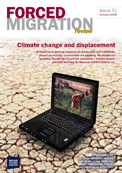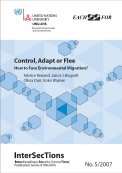The European Parliament’s Policy Department of Citizens’ Rights and Constitutional Affairs has put
out a study on “Climate Refugees: ” Legal
and Policy Responses to Environmentally Induced Migration. This is a welcome addition to the already rife discourse on potential legal and policy responses for environmentally-induced migrants. Specifically, according to the abstract, the study “sets out to examine the legal and policy aspects of climate and environmental related displacement. It assesses to what extent the current EU framework for immigration and asylum in general and the specific instruments in regard to asylum in particular already offer adequate response to climate induced displacement and how the legal framework could evolve in order to provide an improved response to the phenomenon of environmentally induced migration. The study also clarifies in which way such a modified legal framework can be rooted in the Lisbon Treaty including the Charter of Fundamental Rights of the European Union.”
A brief overview of the effects of climate change and the environment on
migration opens the study, but the real meat comes in at page 36 when legal and policy implications are discussed. In sum, they suggest the European Union become a leader in determining solutions.
As at the international level the legal debate is unlikely to be solved in the near term, the EU may decide to be one of the pioneers in this field, in particular because there are already attempts at the political level to consider environmentally displaced individuals under the Common European Asylum Policy. In light of the above, we put forward the followingrecommendations to the European Parliament with the aim of offering different possible mechanisms to be considered by the EU in dealing with environmentally displaced individuals:
- EU may wish to start with the complementary protection regime first, as an ad hoc mechanism and depending on the further evolution to guarantee primary protection to environmental displaced individuals. The national provisions analyzed can be used as a model for the European legislator in amending the content of the Qualification Directive. As long as the reasons listed in the Article 15 shall be applicable to qualify for subsidiary protection, an amendment to its paragraph (c) might include, in addition to armed conflict, also environmental disasters.
- There are strong arguments that, in the case of a mass influx of environmentally displaced individuals, the financial and political mechanisms available under the Temporary Protection Directive might be applicable. However, a more flexible and at the same time more objective mechanism to activate the directive should be considered, as the directive currently can only be activated upon a commission proposal and a related decision by the Council.
- A holistic approach covering all the aspects of environmentally induced migration is a more relevant approach, engaging a comprehensive instrument for environmentally displaced individuals that would regulate the procedure and method, including the rights and obligations, for granting protection
to victims of environmental displacement.
- The EU should consider ad hoc mechanisms informed by a rights-based approach and existing instruments regarding legal and irregular migration (for example prolongation of residence titles for third-country nationals whose countries have been affected by environmental disasters, postponement of removal, etc).
- The EU should promote the resettlement of individuals from countries that have experienced environmental disasters and further develop the Joint EU Resettlement Programme.
Under the Global Approach, third countries affected by climate change related phenomena should be assisted in order to support the national institutions in dealing with adverse environmental change. Measures may comprise strengthening the adaptation and resilience capacities of third countries to reduce the vulnerability of affected populations and enhancing the protection of environmental displaced individuals outside the European Union. The EU should consider providing support to local governments to address migration as an adaptation strategy and to facilitate migration while ensuring that the rights of the migrants are protected during the whole migration cycle. The mobility partnerships would be, in principle, a relevant instrument to bilaterally cooperate on all sorts of measures regarding environmentally displaced.



